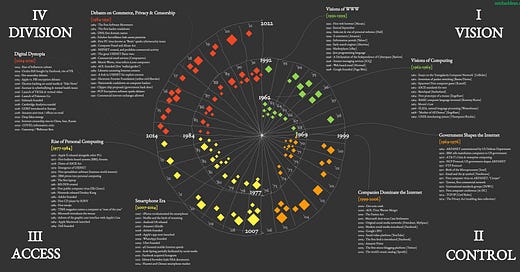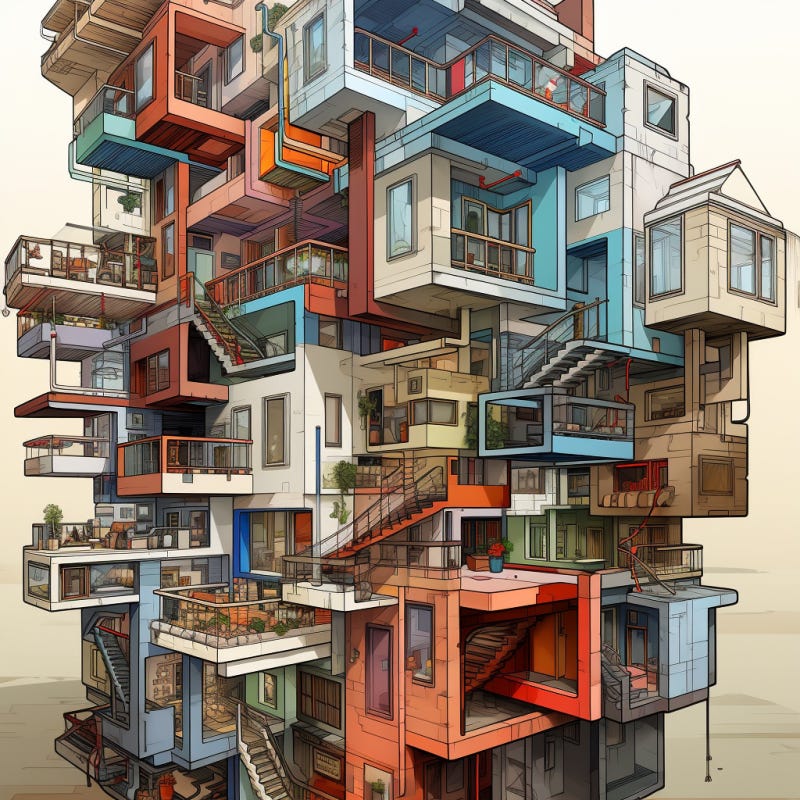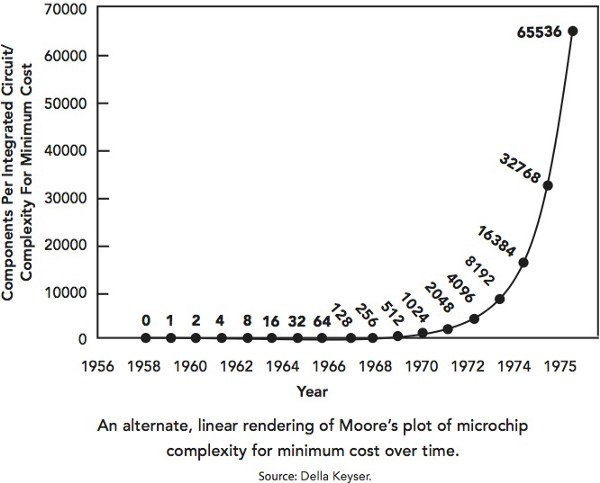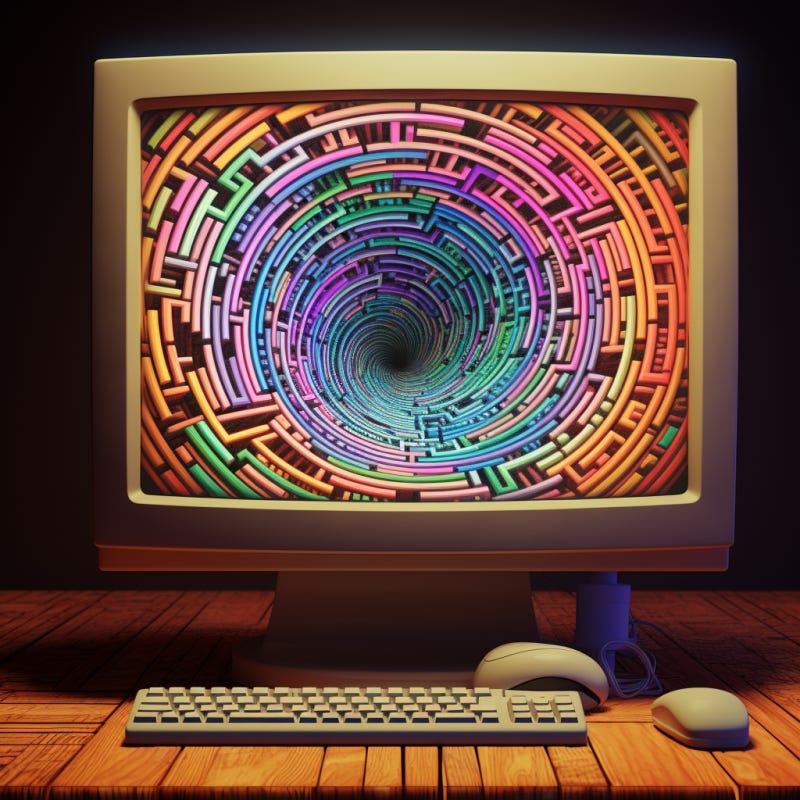In today’s logloglog:
The frustrations of a 17-unit apartment tour.
How I failed in building “Zillow in VR.”
Using the history of the Internet to estimate its future.
Essay flashback:
VR will change how you hunt for apartments and houses. That’s today’s theme (with a heady theory at the end). If you want to read more about spatial technology, check out my two most recent essays on VR/AR. In Teleportation, $97/month, coming soon, I write about Apple’s Vision Pro, and how it’s the first device good enough to enable remote “co-presence.” In Dharma-Vision I unpack my 2023 experiment to wear glasses every day and record my memories.
The nuisance of real estate tours_
Envisioning your new future on Zillow is fun, maybe even therapeutic; but touring is still an absolute nuisance. I hope future generations never have to slide into the backseat of some stranger’s car to get corralled around the city to view ripoff after ripoff.
September 10th, 2023, 10:07 am (EST)
Yesterday I coordinated an apartment hunt for my mother-in-lawn where 5 appointments were spaced out by 45 minutes. I was the driver this time. One was a maze-like 2-family with a built-in landlord, another was in a decrepit “tudor village” with a bedroom that could not fit a bed, the next two were across-the-street-replicas with unreasonably steep entry stairs, and the winner was a 3rd story unit in an elevator building with an epic “bridge view” (never thought that would be an amenity); perfect in every respect, except for the one application ahead of us submitted by the broker’s brother with a sub-500 credit score.
After 4 weeks and 17 apartments, we did it. My wife and I found a 4th floor one-BR for her mother. It was exhausting. Even though Zillow empowers the buyer in many ways, you can never trust the photoshopped pictures you see online. You have to see it in person.
Around 2017, I was the co-founder of a startup trying to fix this.
I remember carrying a glowing-red gaming computer into Zillow’s NYC headquarters. It had a handle and kind of looked like a bomb. What is that? “We’re putting Manhattan in a briefcase (give us your money).” After some bold claims, we piped our digital hallucinations into the eyes of executives.
They were impressed. Our VR-UX was definitely ahead of the curve (albeit, completely unscalable).
“Keep us posted.”
How I failed at building “Zillow in VR” (the short version)_
Our “marketplace” only ever grew to 12 units and we were out of business by 2018. Even though we failed in a commercial sense, it was quite trippy to build and experience something so futuristic. Step-by-step, you could walk around a photo-realistic 3D model of an unbuilt property. An AI-sounding voice actress explained to you all the amenities, and as soon as you found the deal-breaker, you could open a glass panel and teleport into another property. No car ride necessary.
September 15th, 2023, 12:11 am (EST)
Started a VR company in 2015, around 22 years too early.
I still believe that VR is destined to transform architecture, real estate, and basically any industry whose primary feature is it’s “spatiality” (3D-ness), but I was way off on the timing. Smart friends warned me, “isn’t it too early to build a business around this?”
Maybe I ignored their warnings because I was young, putting thousands of people into their first VR experience, and seeing them flip from skepticism to flabbergast. At least one person cried.
But when you’re working with emerging technology, timing matters.
We thought real estate companies could be the “access nodes” of our marketplace. We setup VR stations in sales centers. Traditionally, you can view ~1 building per hour in a standard drive-around. We enabled them to show 12 per hour. Despite the upgrade, they had a critical beef with our product.
“Can’t you stretch the walls in the bedroom to make it look bigger?”
Absolutely not. VR reveals 7’ Manhattan-bedrooms to be exactly as they are, completely unreasonable for a multi-million dollar penthouse. Brokers don’t benefit from a massive catalog with true spatial impressions, buyers do.
“Zillow in VR” isn’t possible until a billion people have their own headset (we’re currently over 20 million, or 2% of the way there).
Doesn’t Apple’s Vision Pro change this? Isn’t this their iPhone moment? Not quite. Think of cell phones in 1992; revolutionary for its 2G, SMS, address book, and pocket-size, but still short of it’s final form.
In 2037, everyone will have a VR headset.
Using the history of the Internet to estimate its future_
As you might know, I’ve been recently enamored with cyclical histories and the Internet’s past. It got me wondering if there were any repeating patterns in the history of computing.
Maybe you think that we’re on an exponential bend, and there are no loops. Since Moore’s Law in 1965, it appears like we’ve been on a relentless march into new territory.
But if you look carefully, it seems like the last 60 years can be broken up into two 30 year loops, each with four seasons that last 7-8 years:
I, VISION: A cycle starts when a new technology inspires a new generation of original thinkers. [The rise of computing (1962), the rise of the web browser (1992), the rise of generative AI (2022)].
II, CONTROL: Following this, a few institutions seize tremendous power that they’ll continue to hold through future seasons [The founding of ARPANET (1969) & the rise of Web 2 companies (1999)].
III, ACCESS: As hardware matures, new segments of the population can get online in new ways. [Personal computing revolution (1977) & the smartphone era (2007)].
IV, DIVISION: Once software & hardware reach maturity, we face their ultimate ramifications. We feud over it until a radical innovation resets the cycle and changes the axis of power. [Debates on online rights (1984) & digital dystopia (2014)].
Here’s a visual I made showing ~10 key milestones per phase:
We only have two full loops, but the arrival of generative AI gives us a third data point (three makes a pattern). The current moment (triggered by Chat GPT) has a spirit of divergent exploration, similar to 1962 and 1992; we’re seeing new, ambitious, and profoundly weird visions of the future.
If Moore’s law can estimate the power of the future, maybe a cyclical theory can estimate the spirit of the eras ahead. This isn’t about precisely predicting the details of the next 30 years. It’s about accurately forecasting the upcoming seasons that everything will unfold within.
Now I’ll undergo the foolish act:
September 15, 2023, 11:38 am (ET)
2022 | Vision | Generative AI is sparking “everything is about to change” sentiments. Will it change the nature of creativity? Will it take our jobs? What happens when content is infinite? It’s terrifying to some, while seizing the imagination of others. Right now we’re in the early “look what it can do!” part of the phase: writing, art, music. But soon, we’ll see it applied in increasingly specific and almost absurd ways, such as “1 million new Beatles songs by 2030.” Take any prior paradigm, and remove the constraints of cost, time, and imagination. In such a shockingly open landscape, it’s one where visions will dominate.
2029 | Control | After this divergent phase, the pendulum swings back to centralization. Institutions will learn the limits and begin to take control. Every emerging category (crypto, AR/VR, AI) could fall into a winner-take-all situation. It’s worth noting the potential curveball here. In 1979 it was the government who took control. In 2009, it was Silicon Valley startups that took control. Some fear AGI itself might experience a “takeoff event,” surpassing human intelligence, becoming sentient, and quickly amassing enough power to compete with companies and governments.
2037 | Access | The Metaverse will finally be possible when spatial hardware reaches maturity. Imagine a sleek pair of glasses paired with upgrades in human computer interfaces and AI. It will kill the need for monitors and phones. This is the logical conclusion of the “remote work” era, and also the last breakthrough in communication tech. We break out of symbolic representations on screens, and extend our perception and (holographic) bodies to anywhere on the planet. The feeling of “teleportation” will be common. Society will adjust to a world where the constraint of location no longer matters, fundamentally changing where and how people live and work.
2045 | Division | A “Singularity” type of situation could radically divide the population on big ethical issues around consciousness, technology, and death. Technology will take on the paradox of being both existential (questioning humanity) and magical (taking on the aesthetic of dreams, psychedelics, and religions). Imagine a cultural awakening similar to the 1960s, but through the vernacular of machines. Science fiction authors like Bruce Sterling (1985) and Greg Egan (1994) painted futures where people were divided into two camps, the “naturalists” and the “cyborgs” (essentially). They disagreed over how far humans should use technology to augment their minds and body. This season might be when debates on transhumanism become real. Should we alter, augment, upload, prolong, extend, or replicate our consciousness?
These seasons happen to fall in line with some notable predictions:
Elon, Open AI, and others anticipate AGI by the end of this decade.
Meta/Apple anticipate spatial tech will mature by mid next decade.
Ray Kurzweil has long said that 2045 will be a “technological singularity.”
The 4 seasons all make sense to me at a zoomed out level; but when you zoom into the details of every day life (like a “real estate tour of the future”), the details seem outlandish.
By the end of this cycle, when I’m old and in my sixties, I won’t need to bug anyone to drive me around for 3 weeks, and I won’t even need a real estate agent. I’ll have an agent — a super-intelligence named Justin II.1 He can scan all of North America’s inventory in 5 seconds, layout all my possessions in each unit, and then run parallel simulations to see how a synthetic version of my consciousness enjoys his quality of life. My VR tour is simply a formality, because Justin II is never wrong.
Another 30 year loop might summon a future that isn’t just stranger than we suppose, but stranger than we can suppose.
Let’s riff:
Are you annoyed with real estate marketplaces as much as I am?
Are you convinced VR/AR technology can replace screens?
Thoughts on my cyclical theory? Any add-ons or pushbacks?
Check out my About page for context, and my Index for all published work.
I deleted this joke because GPT-4 told me it was insensitive: “Like other real estate agents, Justin II has no soul, except he’s impossibly good at his job.” FWIW, I have many real estate agents in my family, and I even got licensed myself.








I see you have embraced Phi as a concept of cyclical time. That graphic was fantastic. Well done man.
There is a wrench in the AGI thing that I think of as cascading ECC failure. ECC is already expensive and technically not perfect at the bit level. At the AGI level I haven’t seen anyone solve this problem. Might be worth looking into.
I’m more curious how VR affects Balaji’s theory of network states. Do they actually take off or is apathy so apart of consuming in 3D that human unity and organization at any level becomes undesirable?
Who cares about VR experience in an apartment if you can’t hear the speaker phone only tenant next door or smell the cat piss stained carpet? Is VR actually a form of sensory deprivation as it transports one sense at the expense of all others? Is VR maturity going to include audio and touch? possible. But aren’t we no where near taste and smell?
More stream of conscious comments but fitting for a logloglog. Always enjoy readying your thoughts. Let’s catch up soon.
Nice spiral. Helpful as I saw the earlier prototype. If only there was a tool that could take a timeline and spiral it up like that. History rhymes, not repeats. Maybe that app will be the new Procreate animation one